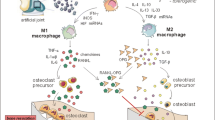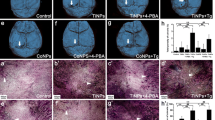Abstract
Macrophage phagocytosis of cement particles with production of inflammatory mediators is a component of the underlying mechanism of aseptic loosening of joint prostheses. Prostaglandin E2 (PGE2), a bone resorbing mediator, has been implicated in the loosening process. Investigations have shown that macrophage phagocytosis of cement particles leads to production of bone-resorbing mediators other than PGE2. In this study, conditioned medium from macrophages exposed to crushed simplex cement particles stimulated osteoblasts to release radiolabeled arachidonic acid and metabolites. Incubation of osteoblasts in conditioned medium from macrophages exposed to cement particles small enough to be phagocytized increased PGE2 release 80-fold over unexposed osteoblasts (P<0.001). Incubation of osteoblasts in conditioned medium from macrophages exposed to particles too large to be phagocytized, or to bone cement filtrate, did not stimulate PGE2 release. We propose that the role of the macrophage in aseptic loosening is primarily to recognize the mechanical failure of the cement mantle by phagocytosis of cement particles and subsequent production of small amounts of specific mediators. These mediators stimulate surrounding osteoblasts to secrete PGE2, which then amplifies the inflammatory response and ultimately results in bone resorption and aseptic loosening.
Similar content being viewed by others
References
Charnley J (1970) The reaction of bone to self-curing acrylic cement. J Bone Joint Surg 52B:340–353
Bell RS, Schatzker J, Fornasier VL, Goodman SB (1985) A study of implant failure in the wagner resurfacing arthroplasty. J Bone Joint Surg 67A:1165–1175
Goldring SR, Schiller AL, Roelke M, Rourke CM, O'Neill DA (1983) The synovial-like membrane at the bone-cement interface in loose total hip replacements and its proposed role in bone lysis. J Bone Joint Surg 64A:575–584
Horowitz SM, Doty SB, Lane JM, Burstein AH (1993) Studies of the mechanism by which the mechanical failure of polymethylmethacrylate leads to bone resorption. J Bone Joint Surg 75A:802–813
Lennox DW, Schofield BH, McDonald DF, Riley LH Jr (1987) A histologic comparison of aseptic loosening of cemented, press-fit and biologic ingrowth prosthesis. CORR 225:171–191
Radin EL, Rubin LT, Thrasner EL, Lanyon LE, Crugnola AM, Schiller AS, Paul IL (1982) Changes in the bone-cement interface total hip replacement. J Bone Joint Surg 64A:1188–1200
Galante JO, Lemons J, Spector M, Wilson PD, Wright TM (1991) The biologic effects of implant materials. J Orthop Res 9:760–775
Freeman MAR, Bradley GW, Revell PA (1982) Observations upon the interface between bone and polymethylmethacrylate cement. J Bone Joint Surg 64A:489–493
Herman JH, Sowder WG, Anderson D, Appel AM, Hopson CN (1989) Polymethylmethacrylate-induced release of bone-resorbing factors. J Bone Joint Surg 71A:1530–1541
Collins DA, Chambers TJ (1991) Effect of prostaglandins E1, E2, and F2 on osteoclast formation in mouse bone marrow cultures. J Bone Miner Res 6(2):157–164
Collins DA, Chambers TJ (1992) Prostaglandin E2 promotes osteoclast formation in murine hematopoietic cultures through an action on hematopoietic cells. C Bone Miner Res 7(5):555–561
Minkin C, Shapiro IM (1986) Osteoclasts, mononuclear phagocytes and physiologic bone resorption. Calcif Tissue Int 39:357–359
Klein DC, Raisz LG (1970) Prostaglandins: stimulation of bone resorption in tissue culture. Endocrinology 86:1436–1440
Tashjian AH, Voelkel EF, Lazzaro M, Goad D, Bosma T, Levine L (1987) Tumor necrosis factor — a (Cahctin) stimulates bone resorption in mouse calvaria via a prostaglandin-mediated mechanism. Endocrinology 120(5):2029–2036
Goodman SB, Chin R-C, Chiou SS, Sung Lee J (1991) Suppression of prostaglandin E2 synthesis in the membrane surrounding particulate polymethylmethacrylate in the rabbit tibia. Clin Orthop 271:300–304
Spector M, Shortkroff S, Hsu H-P, Lane N, Sledge CB, Thornhill TS (1990) Tissue changes around loose prostheses—a canine model to investigate the effects of an antiinflammatory agent. Clin Orthop 261:140–152
Horowitz SM, Glasser DB, Salvati E, Lane JM (1991) Prostaglandin E2 is increased in the synovial fluid of patients with aseptic loosening. J Bone Joint Surg 15:476 #2.
Bockman RS (1981) Prostaglandin production by human blood monocytes and mouse peritoneal macrophages: synthesis dependent on in vitro culture conditions. Prostaglandins 21:9–31
Kurland JI, Bockman R (1978) Prostaglandin E production by human blood monocytes and mouse peritoneal macrophages. J Exp Med 147:952–957
Sudo H, Kodama H, Amagai Y, Yamamoto S, Kasai S (1983) In vitro differentiation and calcification in a new clonal osteogenic cell line derived from newborn mouse calvaria. J Cell Biol 96: 191–198
Rapuano BE, Bockman RS (1991) Tumor necrosis factor alpha stimulates phosphatidylinositol breakdown by phospholipase C to coordinately increase the levels of diacylglycerol, free arachidonic acid and prostaglandins in an osteoblast (MC3T3-E1) cell line. Biochim Biophys Acta 1091:374–384
Horowitz SM, Gautch T, Frondoza CM, Riley L (1991) Macrophage exposure to polymethylmethacrylate leads to mediator release and injury. J Orthop Res 9:406–413
Horowitz SM, Frondoza CG, Lennox DW (1988) Effects of polymethylmethacrylate exposure upon macrophages. J Orthop Res 6:827–832
Franceschi RT, Bhanumathi SI (1992) Relationship between collagen synthesis and expressíon of the osteoblastic phenotype in MC3T3-E1 cells. J Bone Miner Res 7(2):235–246
Kurihara N, Ishizuka S, Kiyoki M, Yoshiyuki H, Ikeda K, Kumegawa M (1986) Effects of 1,25-dihydroxyvitamin D3 on osteoblastic MC3T3-E1 cells. Endocrinology 118:940–947
Pollice PF, Cornejo R, Howard DF, Silverton S, Horowitz SM (1993) Macrophage-stimulated ROS 17/2.8 osteoblasts increase rat osteoclast precursor recruitment in vitro. J Bone Miner Res 8:S385
Sakurai A, Satomi N, Haranaka K (1985) Tumor necrosis factor and the lysosomal enzymes of macrophages or macrophage-like cell line. Cancer Immunol Immunother 20(1):6–10
Vaes G (1988) Cellular biology and biochemical mechanism of bone resorption: a review of recent developments on the formation, activation and mode of action of osteoclasts. Clin Orthop 231:239
Author information
Authors and Affiliations
Rights and permissions
About this article
Cite this article
Horowitz, S.M., Rapuano, B.P., Lane, J.M. et al. The interaction of the macrophage and the osteoblast in the pathophysiology of aseptic loosening of joint replacements. Calcif Tissue Int 54, 320–324 (1994). https://doi.org/10.1007/BF00295957
Received:
Accepted:
Issue Date:
DOI: https://doi.org/10.1007/BF00295957




